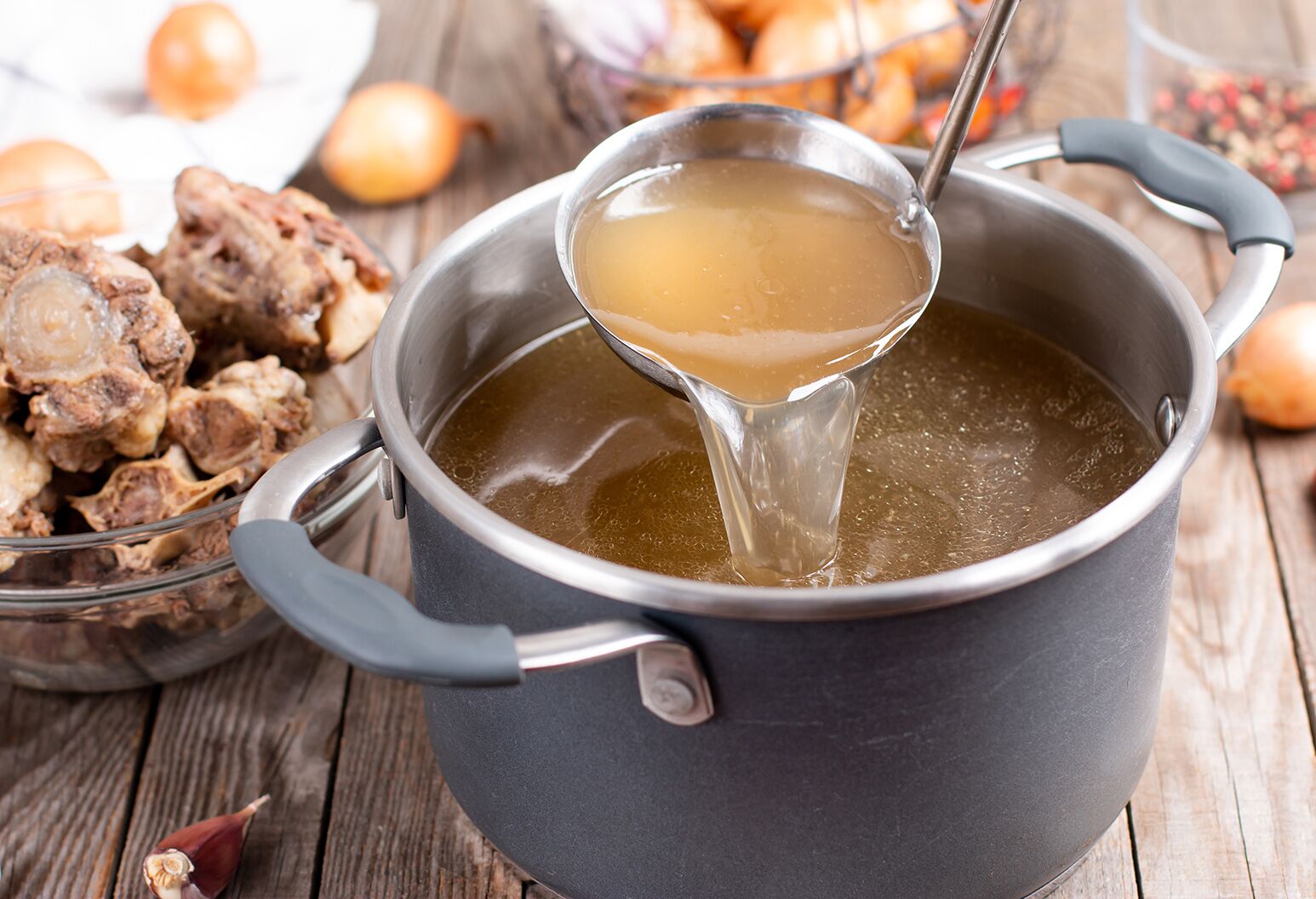The Ultimate Guide to Making and Delighting In Organic Bone Broths at Home
Bone brew has gained focus for its many health benefits and culinary flexibility. Crafting organic bone broth in the house permits individuals to control the high quality of components, ensuring a nutritious result. Understanding the option of bones, crucial flavor components, and correct cooking methods is vital. As the procedure unfolds, one might ask yourself how to elevate their brew beyond the fundamentals and include it into daily dishes for enhanced taste and nutrition.
Comprehending the Wellness Benefits of Bone Broth
Bone broth has been a staple in numerous cuisines for centuries, its health and wellness benefits have actually acquired considerable interest in recent years. Rich in collagen, amino acids, and minerals, bone brew is frequently promoted for its possible to sustain joint health, improve gut function, and enhance skin flexibility. The gelatin stemmed from prepared bones might assist digestion and assistance secure the gut lining, potentially easing issues like dripping digestive tract syndrome.Furthermore, the presence of nutrients such as glucosamine and chondroitin might add to reduced inflammation and pain relief in joints. In addition, bone brew is moistening and can offer as a healthy base for soups and stews. Lots of supporters additionally claim that it increases the immune system, thanks to its mineral profile. In general, the resurgence of passion in bone brew is connected to its regarded capability to advertise total wellness and assistance different bodily features.
Choosing the Right Bones for Optimum Flavor and Nutrition
What elements should one think about when picking bones for broth preparation? The kind of bones utilized substantially impacts both taste and nutritional worth. It is vital to pick bones that consist of a mix of marrow bones, joint bones, and meaningful bones. Marrow bones provide rich tastes and healthy and balanced fats, while joint bones add collagen, enhancing the broth's nutritional profile.Additionally, sourcing bones from grass-fed or pasture-raised animals warranties higher top quality and more nutrients, as these animals are typically healthier. The freshness of the bones is likewise essential; picking bones from local butchers or farmers' markets can guarantee ideal flavor. Bone size matters as well; bigger bones release even more gelatin, causing a richer brew. Finally, taking into consideration the sort of pet-- beef, fish, or chicken-- can affect the last taste, enabling flexible brew options customized to individual choices.
Vital Ingredients for a Tasty Bone Broth

Quality Bone Choice
The structure of a savory bone brew hinges on the cautious choice of top quality bones. Sourcing organic, grass-fed or pasture-raised bones is crucial, as these alternatives are most likely to be devoid of unsafe additives and provide superior nutrients. Selections such as lamb, beef, or poultry bones each give distinct flavors and health and wellness advantages. Bone kinds, including marrow bones, knuckle bones, and oxtails, add gelatin and collagen, enhancing the brew's texture. Picking bones with a mix of meat and connective tissue can also include richness and deepness. In addition, choosing bones with visible marrow assures a nutrient-dense brew, elevating the total top quality. Inevitably, spending time in top quality bone selection lays the groundwork for a scrumptious and nourishing brew.
Fragrant Flavor Enhancers
Picking premium bones establishes the stage for a healthy and rich bone broth, but it is the enhancement of fragrant taste boosters that genuinely elevates the meal. Components such as onions, garlic, and carrots not just present sweet taste yet also add depth to the brew. Fresh natural herbs like parsley, thyme, and bay leaves include an aromatic note, while spices such as black peppercorns and cloves present heat and complexity. Furthermore, including a splash of apple cider vinegar can aid extract minerals from the bones, enhancing the brew. These taste boosters produce an unified blend, transforming a basic broth into a mouthwatering structure for sauces, soups, or stews, making it a flexible component in any kind of cooking repertoire.
Step-by-Step Guide to Making Bone Broth in the house
Developing bone broth at home can be a rewarding cooking endeavor that enhances both flavor and nourishment in various recipes. To begin, one need to pick premium bones, preferably from organic or grass-fed resources. Toasting the bones at 400 ° F for regarding half an hour can increase the taste. Next, transfer the baked bones to a big pot or slow-moving cooker and cover them with cool water. Adding a splash of vinegar aids extract minerals from the bones.Include aromatic vegetables like onions, carrots, and celery for added depth, in addition to herbs and flavors as wanted. Bring the mixture to a boil, then decrease to a simmer. It is necessary to let the broth simmer for a minimum of 12 hours, however longer is more effective for maximum richness. Stress the brew with a fine-mesh screen and store it in impermeable containers, prepared to elevate dishes with its nutritious significance.
Tips for Perfecting Your Bone Broth Simmer
While simmering bone broth, preserving the best temperature and timing is important for accomplishing a savory and abundant result. A mild simmer, ideally between 190 ° F and 210 ° F, helps remove maximum nutrients and flavors without steaming, which can make the broth cloudy. It is suggested to check the pot very closely, changing the heat as needed to maintain this simmer.Timing is likewise essential; a longer simmer, commonly varying from 12 to two days, enables much deeper flavor extraction and collagen release. For chicken bones, a 12 to 24-hour simmer suffices, while beef bones gain from longer food preparation times.Additionally, skimming off any kind of foam or contaminations that rise to the surface during the first few hours can improve the brew's clarity and preference. Making certain the pot is covered during simmering aids to keep moisture and intensify the tastes, making for an extra rewarding end product.
Creative Ways to Use Bone Broth in Your Cooking
Including bone broth into numerous dishes elevates both flavor and dietary value. Cooks and home chefs alike discover that utilizing bone brew as a base for stews and soups boosts depth and richness, transforming basic recipes into passionate dishes. It can also be used in risottos, where the brew changes water, enabling the grains to absorb its tasty essence.Additionally, bone brew functions as an exceptional food preparation liquid for grains like quinoa or rice, infusing them with nutrients and flavor. For an included twist, it can be made use of in braising meats, leading to tender, delicious outcomes. Even sauces profit from a sprinkle of bone broth, enriching their taste profile.Moreover, bone broth can be included right into smoothie mixes for an unanticipated wellness increase, supplying protein and nutrients without compromising taste. These creative applications display the discover here flexibility of bone brew in daily food preparation, making it a vital kitchen staple.
Saving and Maintaining Your Self-made Bone Brew
Proper storage and conservation of homemade bone brew is essential for maintaining its flavor and nutritional benefits. Cold techniques and refrigeration best techniques play a crucial duty in prolonging the brew's service life. Recognizing continue reading this these methods can aid assure that the brew remains delicious and safe for future usage.

Freezing Strategies Described
Freezing techniques are vital for efficiently keeping and preserving home made bone broth, guaranteeing its rich tastes and nutrients continue to be intact for future usage. To freeze bone broth, it is advisable to allow it trendy entirely prior to transferring it to storage containers. Glass containers, silicone molds, or sturdy freezer bags appropriate options. When making use of jars, leave area on top for development throughout freezing. Portioning the broth into smaller quantities permits very easy thawing and reduces waste. Label containers with the day and materials for easy identification. For peak high quality, consume the icy broth within 3 to six months - Organic Bone Broths. Defrosting can be performed in the fridge or by utilizing a microwave, making certain that the broth is heated completely prior to consumption
Refrigeration Best Practices
While lots of emphasis on cold as a method of preservation, refrigeration also plays a necessary duty in saving homemade bone broth effectively. When cooled down, bone broth ought to be moved to airtight containers, assuring marginal air direct exposure to stop wasting. It is recommended to cool brew within two hours of food preparation to keep its top quality. Generally, homemade bone brew can be stored in the fridge for as much as five days. Classifying containers with days can help track freshness. For peak taste and safety, brew must be reheated to a rolling boil before consumption. If longer storage space is called for, freezing stays an excellent option, however proper refrigeration methods assure that bone brew stays nourishing and scrumptious for temporary usage.
Regularly Asked Concerns
Can I Use Frozen Bones for Making Bone Broth?
The question of making use of frozen bones for bone broth develops frequently (Organic Bone Broths). Specialists agree that icy bones can be used successfully, yet they ought to be thawed their explanation prior to food preparation to assure ideal taste and nutrient removal
For How Long Can I Shop Homemade Bone Brew?

Is It Safe to Reheat Bone Broth Multiple Times?
Reheating bone broth numerous times can pose security worries - Benefits Of Bone Broth. Each reheating cycle boosts the danger of bacterial development. It is suggested to reheat just as soon as and keep any type of leftovers immediately to ensure safety and high quality
Can I Add Veggies to the Brew for Taste?
Including vegetables to brew boosts taste and nutritional value. Usual options consist of carrots, onions, and celery. The veggies instill their significance into the brew, creating a richer and extra full-flavored end product.
What's the Finest Means to Thaw Frozen Bone Broth?
To defrost frozen bone brew, one can put it in the refrigerator over night, use a microwave on reduced warm, or submerge the sealed container in cozy water, making certain even defrosting without compromising taste or nutrients. It is crucial to choose bones that consist of a mix of marrow bones, joint bones, and meaty bones. Marrow bones provide healthy and balanced fats and rich tastes, while joint bones contribute collagen, enhancing the brew's dietary profile.Additionally, sourcing bones from grass-fed or pasture-raised animals assurances greater quality and more nutrients, as these animals are generally much healthier. Bone kinds, consisting of marrow bones, knuckle bones, and oxtails, add jelly and collagen, enhancing the broth's appearance. Selecting top notch bones establishes the phase for a abundant and healthy bone brew, but it is the addition of aromatic flavor boosters that truly boosts the dish. Even sauces profit from a dash of bone brew, enhancing their taste profile.Moreover, bone broth can be included right into shakes for an unexpected wellness increase, offering healthy protein and nutrients without endangering preference.